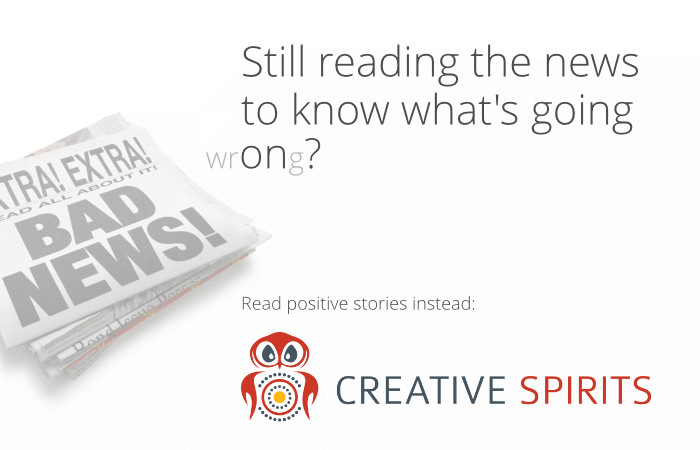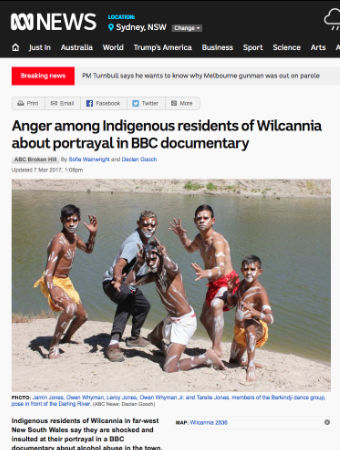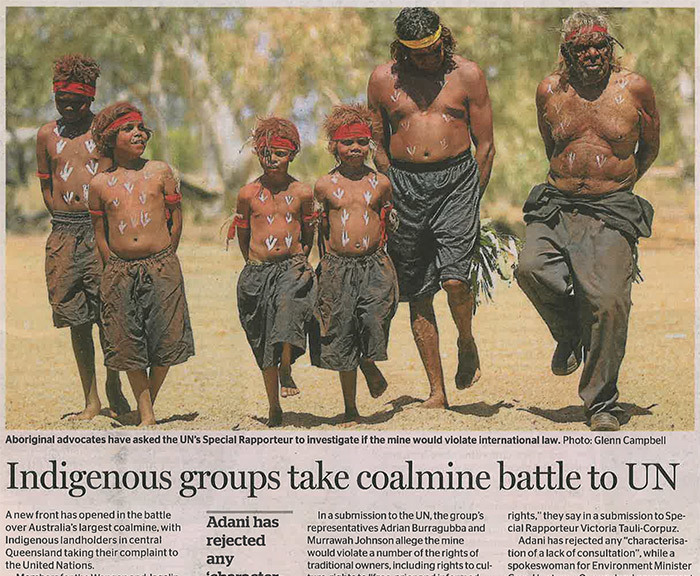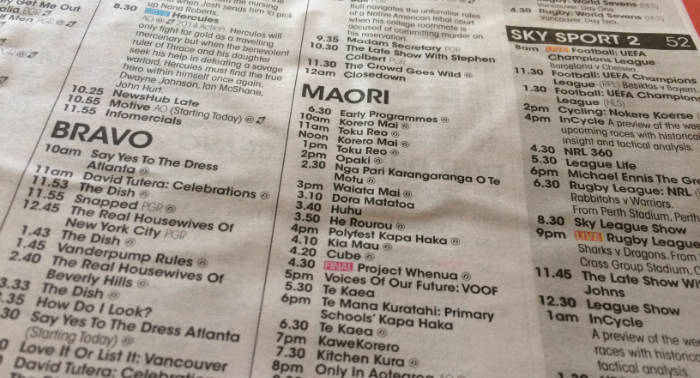Media
Mainstream media coverage of Aboriginal news
Australian media frequently skew their reporting of Aboriginal issues towards common stereotypes and framing. Most media get away with their downputting and ignorant treatment—except one columnist.

Wishing you knew more about Aboriginal culture? Search no more.
Get key foundational knowledge about Aboriginal culture in a fun and engaging way.
This is no ordinary resource: It includes a fictional story, quizzes, crosswords and even a treasure hunt.
Stop feeling bad about not knowing. Make it fun to know better.
Selected statistics
-
40% - Proportion of surveyed Aboriginal people who in 2018 believed the media presents a balanced view of Aboriginal Australians. [1] Figure for 2010: 9%. [2]
-
47% - Proportion of surveyed non-Aboriginal Australians who in 2018 believed the media presents a balanced view of Aboriginal people. [1] Figure for 2010: 16%. [2]
-
50% - Percentage of surveyed Aboriginal people who in 2018 believed media portrayal of Aboriginal people is usually negative. Figure for the general community: 42%. [1]
-
74% - Surveyed proportion of articles about Aboriginal health in 2017 that were negative; that were neutral: 11%; that were positive: 15%. [3]
-
78% - Percentage of test persons who were successfully framed by media messages. [3]
- 81
- Page out of a total of 84 pages on which the Sun Herald reported about "critically endangered" Aboriginal languages. [4]

The 1990s: Aboriginal issues are "problems for the majority culture"
A systematic survey of mainstream media in 1992, including television, news, and radio, found that almost all media studied was not diverse enough, excluding stereotypes. [5]
The discussion about Aboriginal land rights during this time were presented as "problems for the majority culture" and almost as a potential threat to the population as a whole [5]. Unfortunately this mindset is still prevalent in a lot of older Australians.
In 1994 a study found that most editors saw their readership as white, and some conceded that this perception affected their news coverage. With most stories directed at white audiences, papers established a clear sense of conflict between "us" (non-Aboriginal Australians) and "them". [5]
Towards the end of the 1990s only one quarter of relevant articles contained any Aboriginal voices.[5]
There's no news like bad news.
— Jonathan Pryce as media baron Elliot Carver in 007 James Bond's 'Tomorrow Never Dies'
If it bleeds it leads.
— Mantra of the media industry
The 2010s: Selective reporting influences Australians
"If it bleeds it leads," I was once told by a journalist. We are naturally attracted to shocking news and the media serves this attraction. Unfortunately they forget that media also has to be balanced.
Aboriginal television station NITV examined how Aboriginal protests are reported in mainstream media. They found that what's shown on the news can be vastly different to what was going on in the streets. News focus on [6]
- violence (e.g. skirmishes, assaults);
- flag-burning; and
- inflammatory rhetoric.
Rarely do journalists try to find out Aboriginal intentions and what they are trying to achieve with their protests. Yet including a positive Aboriginal story in a major news reel is a great chance to inform, and positively influence, the Australian public.
How the media frames Aboriginal news
Framing is a successful media technique where they try to influence how you organise, perceive, and communicate about reality.
By simplifying reality, media focuses on a subset of relevant aspects of a situation or issue (called 'emphasis frames'). This type of framing is very evident in media's reporting about Aboriginal people and alcohol, for example.
In an experiment, 78% of test persons were successfully framed by the stories that they watched. "The need to question the media is really important," said journalist Ray Martin who reported about the experiment. [3]
Research in 2020 that examined 45 years of print coverage of key moments for Aboriginal self-determination found that Aboriginal perspectives were "rarely presented as legitimate". The researchers examined print coverage of 11 landmark political moments for how the press framed their stories and how they reported Aboriginal actions. [7]
Some media, it found, reported from a "white-mastery" perspective where media considered Aboriginal demands as a thing of the past and assimilation as a positive policy. Media also labelled Aboriginal people as "stoneagers" who have to give up their Aboriginal identity to survive.
Another perspective assumes Aboriginal people as inferior. Thus their rights can only be partially recognised so that there is no threat to the existing government control and power of the Crown.
A perpetual problem perspective assumes that the Aboriginal fight for recognition and rights is an unsolvable problem and puts it into a "tragic light", reiterating nothing can change.
Lastly, a procrastination perspective in mainstream press suggests that change must simply "wait".
The press also tends to treat proposals from non-Aboriginal-dominated groups far more seriously than demands voiced by Aboriginal groups.
Press reactions follow predictable paths, rarely presenting Aboriginal perspectives as legitimate or authoritative.
— Finding of research into 45 years of coverage of Aboriginal affairs [7]
Don't take at face value what we're telling you.
— Ray Martin, journalist [3]
Story: "Unintentionally, I was judging Indigenous people"
In a reflective essay, a student wrote about how the media had subconsciously influenced her perception of Aboriginal people, and the lessons she took away from her realisation: [8]
"I realised that without even speaking, my initial views on Aboriginal and Torres Strait Islander individuals [were] judgemental, perceived as [if] these individuals [were] being up to no good.
"My prejudice[d] views [were] because of what I had seen on the news, reading through articles in newspapers or hearing stories on the radio in the car.
"Unintentionally, I was judging Indigenous people without even knowing or questioning if the source of information was indeed telling the whole story. I decided I had to look further into media and how especially in today’s society, we can be easily manipulated into thinking a certain way by the media."
"I have learnt that information or misinformation in media is presented to the Australian population, labelling Indigenous individuals with stereotypical views... These views become impossible to shift because of media’s false portrayal of Indigenous people and communities. Media plays a significant role in how we perceive other individuals and how we opinion certain individuals, in particular Indigenous people."
"I have realised the media is maybe only telling half the story, and that there is always two sides that must be heard. I have learnt to be inclined to do my own research and see if equality was represented in an article, radio report or news segment on television."
Stereotypical images are just a click away

Again and again journalists writing news are using discriminating stereotypes because they need to sell the news to an audience.
But even if you are writing about another publication getting it wrong, you can easily make the same mistake as your competition, as the screenshot of the ABC article shows.
The ABC reports about a BBC documentary about an Aboriginal community. The BBC failed to balance the footage they shot about alcohol misuse with the community's efforts to curb the abuse.
But in doing so the ABC used a stereotypical image to open the article – a group of painted Aboriginal dancers – rather than doing better than their competition and adding an image that documents the community's efforts and successes in their fight against alcohol. With the image they chose they are merely reinforcing the association of Aboriginal people with painted dancers.
Similarly, when the Sydney Morning Herald reported about a group of Aboriginal people asking the UN to investigate a mining company's potential violations of international law, they used an image showing two adults and four children, bare-chested and painted, and obviously dancing. I doubt that these were part of the "Aboriginal advocates" asking the UN for help as the caption claimed.

Unbalanced coverage – Do black lives matter?
In 2015, a white male with his car hit an 8-year-old Aboriginal boy on a bike, killing him. The man did not stop. He received an 18-month suspended sentence and 6 months in home detention. Media carried on as usual.
But when AFL player Adam Goodes threw an imaginary spear in the same year, there was "wall-to-wall media coverage" about the incident. Aboriginal journalist Amy McQuire wrote at the time [9]:
"The fact that a man walks away with such a light sentence over the death of an Aboriginal child, and Australia stays largely silent about it, says a lot about the different laws in this country – one for black, and one for white. If this was a white kid in a different city, you can bet it would be on the front pages of newspapers around the country. And the fact that this week, we again as a nation would rather debate the latest Adam Goodes controversy, says even more about our unwillingness to confront the real problem in this country – the institutionalised racism that privileges non-Indigenous Australia over the First Peoples of this country."
Media extensively covered the one-punch death of white teenager Cole Miller, but the one-punch death of Aboriginal man Trevor Duroux went almost unnoticed.
No wonder that there is a perception among Aboriginal people that for the media black lives don’t matter, or at least nowhere near as much as white lives.[9]
Aboriginal issues are not 'quirky'
When SBS got under pressure to increase its advertising revenue and ratings in 2015, executive producer of SBS World News, Andrew Clark, wrote to staff directing that stories about "Middle East, indigenous, asylum yarns" which were "of less interest to viewers" should be moved out of a crucial time segment.
Instead, so the manager, "great picture stories, quirky (how could that have happened) yarns are preferable". [10]
Although the broadcaster justified the measure as a "placement" and not "selection" issue, it tells you volumes about how attractive Aboriginal news are to both viewers and media.
The media has a responsibility to tell the country what is happening in a way that connects Australians. If you see that people are not listening to the truth, find another way to tell the story.
— Jeff McMullen, foreign correspondent and strongly pro-Aboriginal journalist [11]
Media shapes opinions – and is sometimes "completely incorrect"
It comes to no surprise that the way media portrays Aboriginal people and topics has a strong influence on readers' perceptions.
What you write – or omit – as a journalist has the power to create outcomes that might not be intended, or even do harm.
For example, when AFL player Adam Goodes called out a teenage fan for calling him an ape in 2013 a long-lasting booing campaign ensued. A press conference the day after, Goodes made it very clear that he did not hold the fan personally responsible, but the culture she grew up in. [12] In fact, he did his best to console and protect the fan as the incident gained more and more media attention.
But in an effort to reduce what happened to a line easy to digest and publish, media reduced Goodes message to saying that the fan was "the face of racism". [12] That was powerful but had devastating consequences.
"The media played a huge role in what happened [following the incident]," says Brett Goodes, Adams' brother, who is a former Bulldogs player. "They could have got behind what Adam was trying to do, to start that conversation." Instead, it became a "media frenzy", with antagonistic commentators "pulling out pieces of what he said to add fuel to the fire. It was just completely incorrect".
What media offices should do
To avoid stereotyping or framing Aboriginal affairs and instead give them the authority and authenticity they need, media offices should [7]
- Hire Aboriginal journalists. By giving editorial and decision-making roles to Aboriginal media makers, the press can shift its perspective away from one that assumes a non-Aboriginal audience afraid of change.
- Review and edit Aboriginal coverage. Check if there is an undertone that protects the interests of the settler communities or suggests Aboriginal people are not capable, or non-Aboriginal communities are not ready to embrace change.
- Accept Aboriginal self-determination. Aboriginal problems need Aboriginal answers, and the experts who know solutions live where the problems are.
- Prominently feature Aboriginal content. This includes using positive language in articles and put articles in the front pages of printed newspapers, or linking to them from prominent places of a paper's homepage.

Australia's media is not diverse enough
Australian media, and in particular the print media, is extremely concentrated with only 3 owners – News Limited, Fairfax Media and APN News and Media – holding approximately 98% of the sector, and two of these owners, News and Fairfax, together holding about 88% of the print media assets in the country [13].
Both the US and the UK also have 3 major corporations, but they only control 26% (US) and 62% (UK) of the circulation [13].
This limits the variety of original news and opinion average Australians consume every day.
It limits in particular how much and in what tone Australians hear about Aboriginal people.
As Sydney-based Ray Jackson, president of the Indigenous Social Justice Association, puts it: "Our media tends to make our issues only front page news on Aboriginal matters when it can be spun into a report whereby all those lazy, drunken, etc, etc, can be blamed for the mistakes of government and their departments." [14]
"Indigenous Australia has long had a troubled relationship with the mainstream media," says Brooke Boney of SBS News who cites Aboriginal radio host, Tiga Bayles as saying that media "put a slant on it to make [Aboriginal people] look bad". [15]
Even established media organisations can get it wrong. The tax-funded Australian Broadcasting Corporation had to pay Aboriginal woman Rosalie Kunoth-Monks more than $130,000 for defamation [15].
No surprise, then, that Aboriginal people are hesitant to talk to mainstream media. “The media does not look at us in a good light at all and hence my hesitation to speak to mainstream media. I keep to myself,” says Ms Kunoth-Monks.
A 2015 survey of more than 350 articles about Aboriginal health, published over a 12-month period, backs her up. Almost 75% of these articles were negative, 11% neutral and only 15% positive [16]. The problem is that reiterating negative stereotypes lets people expect them the next time they read about these topics and fuels prejudice, misconceptions, racism and ignorance.
Boney asks: "The question that Indigenous media observers have to ask: is this genuine lack of understanding of Indigenous stories or a lazy reliance on old racist stereotypes?"
We should, and will, create channels in print, digital and broadcasts to amplify the story of Indigenous excellence.
— Jason Glanville, CEO, National Centre of Indigenous Excellence [17]
Story: Bomb attack or prank?
The facts: An explosive device was hurled at a group of people in the One Mile community, on the outskirts of Broome. A woman picked up the object as it exploded, suffering serious injuries. Two other people, including a 13-year-old girl, were also injured.
This should be headline news all over the country, shouldn't it?
Not in Australia. The Chinese national press agency Xinhua covered the attack, yet most of the Australian media ignored it.
In similar circumstances, papers usually use labels such as “potential hate crime” or “terrorist attack”, but in this instance the event was downplayed to a “prank that's gone seriously wrong”.
It is telling that news from Aboriginal communities rarely gets covered unless the government cites a “national emergency” to justify deploying defence forces into communities.
It is also telling that on the rare occasions when we hear about violence on the communities, it tends to focus on internal community violence and not violence perpetuated upon a community by outsiders.
Video: Aboriginal representation in the media
Watch Francis Kelly talk about the history of the Warlpiri Media Association, learn about BRACS, ICTV and NITV.
Journalist accused of racial vilification
Nine high-profile, light-skinned Aboriginal people in 2010 took Herald Sun newspaper columnist, Andrew Bolt, to court claiming racial vilification over articles he had published. [18]
He had described the complainants 'fair-skinned' and 'professional Aborigines' in the articles headlined 'It's so hip to be black' and 'White fellas in the black'. The articles suggested the group was 'rorting the system' and gaining benefit by identifying with only one aspect of their cultural heritage.
I certainly don't accuse them of opportunism, even if full-blood Aborigines may wonder how such fair people can claim to be one of them and in some cases take black jobs.
— Andrew Bolt in his article 'It's so hip to be black' [19]. Note the use of derogative terms.
The plaintiffs claimed the publications breached the Racial Discrimination Act. They did not seek financial compensation, but merely an apology from Mr Bolt's employer and the removal of the offending articles. One of the articles was still online in May 2011.
In October 2011 Justice Bromberg ruled that Andrew Bolt and his employer, the Herald & Weekly Times, had in fact breached the Racial Discrimination Act 1975 [20].
Mr Bolt admitted that the Aboriginal people he had mentioned in his article were of Aboriginal descent and genuinely self-identified as Aboriginal people. But he denied that they were offended by the articles [21].
Justice Bromberg disagreed and found that the articles "contained erroneous facts, distortions of the truth and inflammatory and provocative language". As a result Mr Bolt's conduct was in breach of section 18D of the Act.
Mr Bolt admitted to having failed to contact any of the people mentioned in the article, that some of his mainly online sources may have been incorrect, and that he had erred in places.
In his judgement the justice noted "that young Aboriginal persons or others with vulnerability in relation to their identity, may be apprehensive to identify as Aboriginal or publicly identify as Aboriginal, as a result of witnessing the ferocity of Mr Bolt's attack on the individuals dealt with in the articles."
It is important to note that the judge's ruling is not about the freedom of speech, as Mr Bolt and his supporters tried to point out. The case was about Mr Bolt's conduct and manner and the way he had written the articles.
I rejoiced in the success of the case against Mr Bolt because I felt it was a win for those of us who were tired of being made to feel ashamed of our heritage; for those of us who have been told, after revealing we are Aboriginal, "Well, at least you don't look it."
— Deahnna Richardson [22]
We are not saying that you can't talk about racist issues. What the judgement clearly said was that it's how you handle it. You cannot be malicious; you must handle it based on truth and fact, not fiction and racism.
— Pat Eatock, Aboriginal pensioner and activist, one of the group who filed the case against Andrew Bolt [21]
Justice Bromberg 'got' that Aboriginality is a lived experience, not just something where people can flick a lever and say you are or you aren't.
— Mark McMillan, Aboriginal lawyer and one of the people mentioned in the article [21]
How can you complain about inappropriate media coverage?
If you believe any media has put Aboriginal people or culture into a wrong perspective you can report it to the Australian Communications and Media Authority (ACMA).
Contact ACMA to complain about something you've seen on TV, heard on the radio or seen on the Internet.
